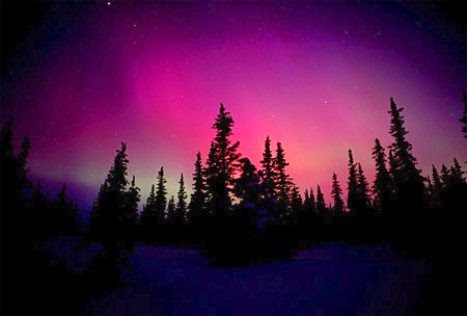An aurora is a
natural light display in the sky particularly in the high latitude (Arctic and
Antarctic) regions, caused by the collision of energetic charged particles with
atoms in the high altitude atmosphere (thermosphere). The charged particles
originate in the magnetosphere and solar wind and, on Earth, are directed by
the Earth's magnetic field into the atmosphere. Most aurorae occur in a band known
as the auroral zone, which is typically 3° to 6° in latitudinal extent and at
all local times or longitudes. The auroral zone is typically 10° to 20° from
the magnetic pole defined by the axis of the Earth's magnetic dipole. During a
geomagnetic storm, the auroral zone expands to lower latitudes.
Aurorae are
classified as diffuse and discrete. The diffuse aurora is a featureless glow in
the sky that may not be visible to the naked eye, even on a dark night. It
defines the extent of the auroral zone. The discrete aurorae are sharply
defined features within the diffuse aurora that vary in brightness from just
barely visible to the naked eye, to bright enough to read a newspaper by at
night. Discrete aurorae are usually seen in only the night sky, because they
are not as bright as the sunlit sky. Aurorae occasionally occur poleward of the
auroral zone as diffuse patches or arcs, which are generally subvisual.
In northern
latitudes, the effect is known as the aurora borealis (or the northern lights),
named after the Roman goddess of dawn, Aurora, and the Greek name for the north
wind, Boreas, by Pierre Gassendi in 1621. Auroras seen near the magnetic pole
may be high overhead, but from farther away, they illuminate the northern
horizon as a greenish glow or sometimes a faint red, as if the Sun were rising
from an unusual direction. Discrete aurorae often display magnetic field lines
or curtain-like structures, and can change within seconds or glow unchanging
for hours, most often in fluorescent green. The aurora borealis most often
occurs near the equinoxes. The northern lights have had a number of names
throughout history. The Cree call this phenomenon the "Dance of the
Spirits". In Medieval Europe, the auroras were commonly believed to be a
sign from God.
Its southern
counterpart, the aurora australis (or the southern lights), has features that
are almost identical to the aurora borealis and changes simultaneously with
changes in the northern auroral zone. It is visible from high southern
latitudes in Antarctica, South America, New Zealand, and Australia. Aurorae
occur on other planets. Similar to the Earth's aurora, they are visible close
to the planet's magnetic poles. Modern style guides recommend that the names of
meteorological phenomena, such as aurora borealis, be uncapitalized.


